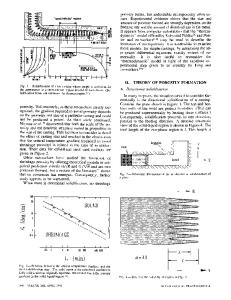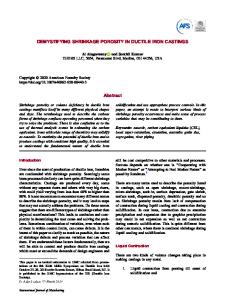Simulation of Shrinkage Porosity Formation During Alloy Solidification
- PDF / 7,192,606 Bytes
- 16 Pages / 593.972 x 792 pts Page_size
- 23 Downloads / 430 Views
RODUCTION
SOLIDIFICATION shrinkage related porosity is a defect of foremost concern in the metal casting industry. Shrinkage porosity reduces the mechanical performance of cast parts, causes leaks, and is generally unacceptable to customers of foundries.[1–3] It occurs when the liquid melt can no longer feed the volume contraction of a metal alloy during solidification. Usually, shrinkage porosity is combatted by adding so-called risers or feeders to the mold during casting. Nevertheless, when the feeding path from the risers is cut off, surface sinks and internal holes will develop. Figure 1 shows examples of such shrinkage related defects. For more than 30 years now, computer casting simulation software has been used to design casting rigging systems that avoid porosity while keeping the number and size of risers and other feeding aids to a minimum. However, the mathematical models underlying such simulations are often highly simplified and do not accurately predict the location, extent, type, and amount of shrinkage porosity in a casting.
VAHID KHALAJZADEH and CHRISTOPH BECKERMANN are with the Department of Mechanical Engineering, University of Iowa, Iowa City, IA 52242. Contact e-mail: [email protected] Manuscript submitted December 4, 2019.
METALLURGICAL AND MATERIALS TRANSACTIONS A
The early studies by Piwonka and Flemings[4] and Kubo and Pehlke[5] have inspired numerous advancements in understanding and modeling of porosity formation during alloy solidification. The advances include but are not limited to: applying three-dimensional (3D) models for the calculation of the liquid pressure, feeding velocity, and porosity distributions during solidification, including the effects of dissolved gases, using dynamic mesh refinement algorithms for the semi-solid mushy zone, tracking the liquid surface movement due to solidification shrinkage with a volume-of-fluid (VOF) method, and developing physics-based theories for the onset of pore nucleation.[6–15] Summaries of these previous studies can be found in review papers.[16–18] Although the modeling of shrinkage porosity in castings has progressed significantly, a model that simultaneously predicts sinks and pipes emanating from a surface, internal macro-porosity holes, and distributed microporosity is still lacking. Aside from the fact that previous models are not sufficiently comprehensive for use in casting simulation, another main shortcoming is the lack of a realistic treatment of when and where shrinkage porosity nucleates and how it spreads. The present paper is a continuation of the recent study by Khalajzadeh et al.,[19] who investigated the formation of shrinkage porosity in an aluminum alloy wedge casting using real-time video radiography. The images in the recorded video were processed to obtain quantitatively accurate pore volume fraction fields in the
Fig. 1—Surface sinks and internal porosity defects caused by solidification shrinkage: (a) a depression or sink on the top surface of a cast aluminum block, (b) internal macro-shrinkage hole in a steel ca
Data Loading...











